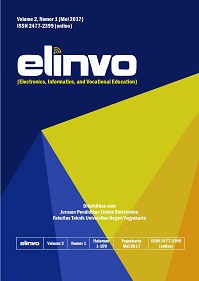Differences in Software Usability Level Based on User Background
DOI:
https://doi.org/10.21831/elinvo.v8i2.54255Keywords:
usability, software quality, user backgroundAbstract
The development of software must consider usability as one of its key success indicators. Relatively few studies discuss the factors influencing usability, including users' backgrounds. The purpose of this research was to investigate the impact of user background, specifically gender, class (year of college admission), and frequency of use on the rating of usability. This research utilized a descriptive quantitative method with instruments: the usability matrix of the Computer System Usability Questionnaire (CSUQ), the System Usability Scale (SUS), the Usability Metric for User Experience (UMUX), and the Net Promoter Score (NPS). The research object was the Learning Management System (LMS) of two state universities in Yogyakarta. Two sets of questionnaire responses were obtained: 305 men and 442 women answered the first time, and 280 men and 584 women answered the second time. Our result shows that the mean value of usability level from CSUQ, SUS, UMUX, and NPS is mostly higher in female than male respondents, in junior to more senior students, and in respondents who use the system more frequently than those who use it less. This trend was consistent, even though the sequence of questionnaire choice order was reversed between the first and second data collection at the two universities. This research hence concluded that, based on gender, women tend to offer a higher rating of usability than men; based on class, the younger generation tends to provide higher ratings of usability than the older generation, and users who use the system more frequently tend to give higher usability rating than those who less use it.
References
W. Nakamura, E. Oliveira, and T. Conte, "Applying Design Science Research to develop a Technique to Evaluate the Usability and User eXperience of Learning Management Systems," in XXIX Simpósio Brasileiro de Informática na Educaí§í£o (Brazilian Symposium on Computers in Education), 2018, p. 953.
M. Einggi Gusti Pratama and W. Andhyka Kusuma, "Penggunaan Learning Management System (LMS) Untuk Pembelajaran Dimasa Pandemi," J. Syntax Admiration, vol. 2, no. 8, pp. 1545–1554, Aug. 2021.
I. P. A. Purnawan, I. K. G. Darma Putra, and N. K. D. Rusjayanthi, "Evaluasi Usability dan User Experience LMS OASE Universitas Udayana Menggunakan Metode Tuxel 2.0," J. Nas. Pendidik. Tek. Inform., vol. 10, no. 3, p. 177, Dec. 2021.
N. Harefa, Learning Management System: Aplikasi E-Learning untuk Pembelajaran Online dan Blended. Jakarta Timur: UKI Press, 2020.
I. Rochmawati, "iwearup.com User Interface Analysis," Visualita, vol. 7, no. 2, pp. 31–44, Feb. 2019.
B. Igler, T. Braumann, and S. Bí¶hm, "Evaluating the Usability of Mobile Applications," Int. J. Bus. Manag. Stud., vol. 5, no. 1, pp. 92–102, 2013.
P. Utami, F. R. Pahlevi, D. Santoso, N. Fajaryati, B. Destiana, and M. E. Ismail, "Android-based applications on teaching skills based on TPACK analysis," in IOP Conference Series: Materials Science and Engineering, 2019, vol. 535, no. 1.
R. N. Akbar, "Perancangan Dan Analisa User Interface Website Abelima Menggunakan Computer System Usability Questionnaire (CSUQ)," Universitas Islam Negeri Sultan Syarif Kasim Riau, 2017.
M. Yusuf and Y. Astuti, "System Usability Scale (SUS) Untuk Pengujian Usability Pada Pijar Career Center," Komputika J. Sist. Komput., vol. 9, no. 2, pp. 131–138, Oct. 2020.
M. Rizky, "Analisis User Experience Pada Aplikasi Transportasi Online Menggunakan Standar Usability Metric For User Experience (UMUX)," Institut Teknologi Telkom Purwokerto, 2021.
E. Roselina, "Pemetaan Profil Pasien/Klien Rumah Sakit Umum Daerah (RSUD) Kota X Menggunakan Net Promoter Score," J. Vokasi Indones., vol. 4, no. 1, Sep. 2016.
A. W. Kurniawan and Z. Puspitaningtyas, Metode Penelitian Kuantitatif. Yogyakarta: Pandiva Buku, 2016.
A. Ali, Quantitative Data Analysis. 2021.
Nasir and Sukmawati, "Analysis of Research Data Quantitative and Qualitative," Edumaspul J. Pendidik., vol. 7, no. 1368–373, 2023.
T. D. Soesilo, Penelitian Inferensial dalam Bidang Pendidikan. Satya Wacana University Press, 2018.
I. Jayusman and O. A. K. Shavab, "Aktivitas Belajar Mahasiswa Dengan Menggunakan Media Pembelajaran Learning Management System (LMS) Berbasis Edmodo Dalam Pembelajaran Sejarah,"," J. Artefak, vol. 7, no. 1, p. 13, Apr. 2020.
Hardani et al., Metode Penelitan Kualitatif & Kuantitatif. Yogyakarta: CV. Pustaka Ilmu, 2020.
A. Taufik and R. Doharma, "Efektivitas Tingkat Penggunaan (Usability) ResearchGate Sebagai Media dalam Membantu Indeksasi Publikasi Karya Ilmiah," JATISI (Jurnal Tek. Inform. dan Sist. Informasi), vol. 9, no. 3, pp. 2699–2715, 2022.
K. Abdullah et al., Metodologi Penelitian Kuantitatif. Pidie: Yayasan Penerbit Muhammad Zaini, 2022.
J. R. Lewis, "IBM computer usability satisfaction questionnaires: Psychometric evaluation and instructions for use," Int. J. Hum. Comput. Interact., vol. 7, no. 1, pp. 57–78, Jan. 1995.
J. R. Lewis, "Usability: Lessons Learned ... and Yet to Be Learned," Int. J. Hum. Comput. Interact., vol. 30, no. 9, pp. 663–684, Sep. 2014.
J. Brooke, "SUS: A Retrospective," JUS J. Usability Stud., vol. 8, no. 2, pp. 29–40, 2013.
J. Brooke, "SUS -- a quick and dirty usability scale," in Usability Evaluation in Industry, 1996, pp. 189–194.
N. Satmetrix, "Net Promoter Score: A Metric from the Experts," Satmetrix. [Online]. Available: https://www.satmetrix.com/nps-score-model/. [Accessed: 01-Nov-2020].
K. Finstad, "The Usability Metric for User Experience," Interact. Comput., vol. 22, no. 5, pp. 323–327, Sep. 2010.
H. E. Puteri, "Menentukan Populasi dan Sampel Dalam Riset-Riset Ekonomi Dan Perbankan Islam," 2020.
Pdd.-P. D. P. Tinggi, "Profil Perguruan Tinggi," PDDikti, 2020. [Online]. Available: https://pddikti.kemdikbud.go.id/data_pt/QTA0QUFGRjgtNUY4MS00NzU2LUI5MTQtNzNEQ0ZFRDMzOTMy. [Accessed: 27-Oct-2022].
Downloads
Published
How to Cite
Issue
Section
Citation Check
License
The article published in ELINVO became ELINVO's right in publication.
This work by ELINVO is licensed under a Creative Commons Attribution-NonCommercial 4.0 International License.








